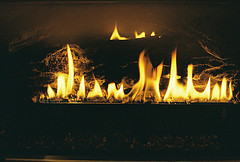
by blogediter | Mar 11, 2019 | Gas Logs
Jason – I converted my masonry fireplace with natural gas and installed an unvented gas log set. Can I install a Chimney Balloon above the damper, keeping the damper closed and ignite my gas logs without incurring any damage to the Chimney Balloon? The gas log set is rated at 39K but. Thanks, CB
Dear CB, If the temperature in the flue gets to about 200 degrees Fahrenheit it will trigger the release mechanism in the Chimney Balloon. Essentially the Chimney Balloon membrane melts and shrinks at the same time and the Chimney Balloon falls out of the Chimney. I’m betting that you will get heat conducting through your damper that will exceed 170 degrees within minutes with this vent free gas log turned on. Unfortunately, the metal from the damper will conduct the heat right through.
On the other hand, it will benefit you to use a Chimney Balloon above the damper when you are not using the fireplace. This is how it is normally used and it will keep your nice warm inside air inside where it belongs and not be floating up past a leaky damper.
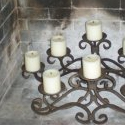
by blogediter | Mar 8, 2019 | Fireplaces
Jason – If the Chimney Balloon fireplace damper is inserted in the flue can you still burn candles in the fireplace? Thanks! – NC
Dear NC, The answer to this questions is a definitive…sometimes.
You see, the Chimney Balloon is designed to burst and release at right around 200 degrees Fahrenheit. So if you burned a few candles and kept about a 3′ distance between the flame and the Chimney Balloon and kept your glass doors open (if you have them) then you will probably be OK to leave the Chimney Balloon in while burning the candles.
I know my wife has lit candles for up to 4 hours in our fireplace and not removed the Chimney Balloon and everything was fine. The key is to keep the wicks trimmed on the candles. If you get along yellow flame on your candle you can really get some serious heat coming from a candle that might get over 200 degrees.
So keep the candles short and away from the Chimney Balloon, keep the wicks trimmed, and keep your glass doors open and you should be fine.
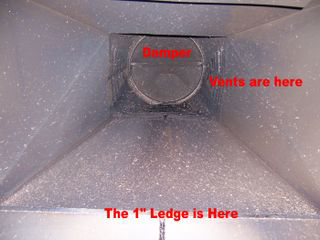
by blogediter | Mar 6, 2019 | Fireplaces
Q: Jason, I have a Heatilator Mark 123 fireplace that has a fireplace damper that is actuated by a pull chain. It is very cold in the winter and I can feel a draft come down and out of the fireplace. I see that you recommend putting the Chimney Balloon in above the damper, but the damper is about 3′ up in this application. Also, just below the damper, the walls of the flue in this area are perforated by a series of linear vent slots in an area that is about 10″ vertically. The firebox of this fireplace is trapezoid in shape (25″ length in back, 32″ length in front and 16″ from front to back) and lined with firebrick. There is a slight 1″ ledge just above the firebrick and then the metal flue immediately starts gathering upwards like an upside down funnel. My question is…where do I install the Chimney Balloon? Above the damper, below the damper, or just above the firebricks and the firebox? – FF
A: Hi FF, This Heatilator fireplace is a very common fireplace (especially in condos) and we are often asked about this particular application. We have found that it is possible to put a Chimney Balloon in any of these locations you mentioned, but installing a Chimney Balloon just above the firebox on the 1″ ledge is by far the easiest install point.
How to do the Low Install on the 1″ Ledge:
Take a 36×15 Chimney Balloon plug and unroll it out of the package so it is flat. Hold the Chimney Balloon by the valve handle in one hand and connect the inflation tube to the Chimney Balloon, and then connect the other end of that inflation tube to a Chimney Balloon pump. You will find it is easier to do this install with a pump since you will need both hands to get the Chimney Balloon into place as it inflates.
Tuck the Chimney Balloon material around all 4 edges of the ledge that is just above firebox while you hold the Chimney Balloon in place with your other hand. When you have the balloon roughly in place turn on the pump and it will start to inflate. As it inflates continue to hold the balloon in place with one hand by holding the handle valve. At the same time use your other hand to continuously work the edges of the balloon material and make sure it is staying above the ledge as you inflate. As the balloon gets tighter you will feel it start to grab and lodge itself in place.
* Note* Do not adjust the position of the Chimney Balloon while it is fully inflated. If you need to adjust its position leave the valve open and let some air escape first so the Chimney Balloon will be more pliable.
The Chimney Balloon may be slightly visible from the hearth since the install is very low, but the clear Chimney Balloon is hardly noticeable especially if you close the spark screen.
How to do the High Install just above the damper:
For a bit more of a challenge you can install a 9×9 Chimney Balloon in the flue just above the damper but you will need an Extra long 26″ HEK Extender for the handle (the 26″ is a special sized HEK extender that is not listed on the website yet, so you will need to call in your order). Attach the extra long HEK extender to the 9×9 Chimney balloon and unfold the flattened Chimney Balloon, so it is perpendicular to the long handle. Put the Chimney Balloon through the open damper so the handle sticks down through the open damper door and then inflate the Chimney Balloon into place. It is a bit tricky to get the Chimney Balloon to inflate flat in an area that is so high, so you may want to have your folding carpenters ruler handy to prod it into place if necessary. This higher install also seals well, it is just a little harder to do.
– Jason
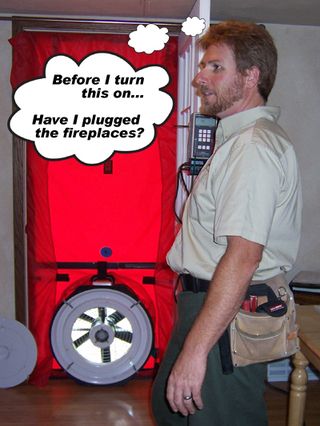
by blogediter | Mar 4, 2019 | Save Energy
Blower Door Testing
I love going to tradeshows because it is a time that service professionals like Energy Raters and Chimney Sweeps can give us feedback on the applications that they use the Chimney Balloon in. At the 2009 ACI Conference in Kansas City, some energy auditors told us about how they use the Chimney Balloon to solve a very common fireplace soot issue during blower door testing.
Every rookie energy rater makes this mistake at least once. You go to a home to do an energy audit and just go straight to setting up the blower door kit. You look around the house and close up all the exterior doors and windows but completely neglect to look at the fireplaces. You fire up the blower door and suddenly notice a gathering grey soot cloud billowing from the living room. You know what you did wrong, you forgot to seal the fireplace. But it is too late…you already sucked a bunch of soot down the chimney and into the home. This makes the homeowner pretty ticked off and is not a good first impression.
Sometimes this even happens if you have the fireplace damper closed. Chimneys are filled with dust, and loose soot and metal dampers are notoriously leaky, so when you bring a house down to -50 pascal you can suck an enormous amount of air through the chimney and that will draw the loose soot and dust down too. It is like taking a drinking straw that has dust lined on the inside of it and briskly inhaling through it. *cough*cough*
The old school method is to take a wet towel and toss it over the ashes in the firebox, but that doesn’t do anything for the soot that comes down the chimney. Or you can take plastic and tape it around the hearth to try to seal it that way but bricks are difficult to seal against and the tape can leave a residue. Also, this takes time to cut and tape off the plastic.
The easiest thing to do is keep a couple of the common sized Chimney Balloons handy (like a 9×9, 12×12, 24×12 and 36×15) and a Chimney Balloon pump handy and quickly inflate a Chimney Balloon in the fireplace before you start the blower door. This solution is quick and easy, and it seals nice and tight so you don’t take any chances.
The energy raters I spoke with offer Chimney Balloons to their customers as an additional product in their energy rating. So when they put the Chimney Balloon in, they bring the homeowner over to show them what they are doing and explain how sealing off the flue is a benefit not only for the blower door test but also for saving energy long term as well. 99% of the time the homeowner then asks the rater to just leave the Chimney Balloon in place and bill them for it. After all, it is probably one of the least expensive and simple improvements the homeowner can make that will significantly improve the blower door test results.
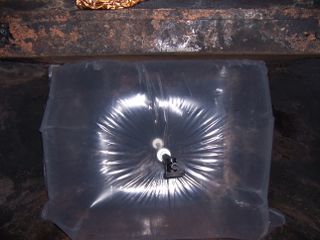
by blogediter | Mar 1, 2019 | Chimney Plugs
Chimney Balloons
The Chimney Balloon has become quite a topic of conversation for green energy and green tech bloggers.
The Chimney Balloon is referred to in so many ways. People call it: “an inflatable baffle, chimney seal, flue baffle, inflatable damper, chimney plug, chimney draft stopper, even a draft dodger!
Here is a link to an article that was written by a very well respected green blogger on the Plant Green website, his name is Josh Peterson:
“…That is where a Chimney Balloon comes in. A Chimney Balloon or Chimney Pillow is a reusable, durable plastic balloon that fits in the chimney under the flue and blocks out the cold air. Inflate the balloon and wedge it up near the flue. A Chimney Balloon can save you about $200-$500 dollars a year in heating costs.
Don’t forget to remove the Chimney Balloon before you start a fire. You should put a note on the fireplace door to remind you that the Chimney Balloon is up there. If exposed to heat, the Chimney Balloon will deflate. I assume it just falls into the fire at that point. It’s like a Chimney Balloon Icarus…” Click here to read the whole article




